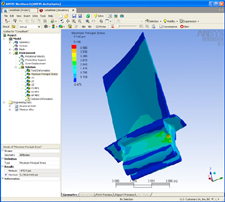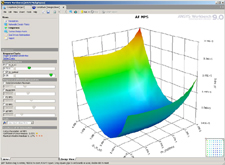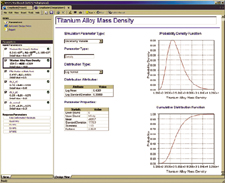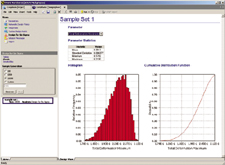Latest News
August 1, 2004
By Louise Elliott
If large organizations define their costs only as product development and manufacturing, they leave out the costs of poor quality—in rework, warranty costs, recall, and customer dissatisfaction,” says Dr. Andreas Vlahinos, head of Advanced Engineering Solutions, in Castle Rock, Colorado. And when that happens, the bottomline results can be disastrous.
So, how do large organizations prevent such costs from eroding profitability and success? Vlahinos, a consultant to quality engineers in the automotive industry, says it’s imperative to focus on the big picture and build variability, which simply reflects the real world, into their product development. Probabilistic studies offer the tools to enable them to do that.
ANSYS (Canonsburg, PA) was first out of the gate with probabilistic tools in 2000 when it released Probabilistic Design, currently available as part of ANSYS 8.1, and as DesignXplorer VT in ANSYS Workbench. Now the company has a number of customers who use the tools to improve the overall quality and reliability of their products.
“Probabilistic studies make it possible to quantify the quality of products, and not just go by gut feelings or customer perception,” says Stefan Reh, team leader for Optimization and Probabilistic Design for ANSYS. “It gives the user a number that states the chance of failure over time.”
Catching Problems Before They OccurReh points out that probabilistic studies offer a second phase of analysis. The first, which he calls an exploration phase—performed with tools like FEA (finite element analysis), CFD (computational fluid dynamics), and motion simulation—is where users vary input values and perform a number of analysis iterations. He calls the second “an exploitation phase,” when the inputs and results of those first-phase analyses are used for probabilistic purposes.
This probabilistic phase uses the variations represented by the input and output parameters to get a statistical distribution of the results. ANSYS provides two probabilistic methods—Monte Carlo simulations and response surface studies. In Monte Carlo simulation, the system randomly samples the input variables. For the response surface method, says Reh, “first you need to find an approximative relationship between input and output parameters, which is called the response surface.”
Reh has a background in the gas turbine business, in particular with turbines used for electricity generation. Power plant owners demand super-protective manufacturers’ warranties. “It’s not unheard of that a customer charges the manufacturer $100,000 per day for each day a power plant goes down due to a gas turbine failure,” he says.
But analyzing gas turbines is difficult. “Nobody knows exactly how hot the turbine blades become inside a gas turbine with combustion gas streaming around the blades at temperatures of 1800 degrees Fahrenheit to 2200 degrees Fahrenheit,” says Reh. “while the blades rotate at 3600 rpm. Even the most sophisticated analysis that can be done in such an environment delivers no more than an estimate.”
All the uncertainties involved in such operating conditions can multiply, causing some of the turbine’s blades to become much hotter than expected, reducing the strength of the material and leading to premature blade failure. An overheated blade can break off even before the warranty period has expired. If that happens, Reh says, “an avalanche effect is set into motion. The ripped-off blade takes the next one…with it. Then those two blades take more; until the result is devastating and expensive damage to the entire machine. The goal of using probabilistic design in such a case is to estimate how many such failures we may run into—and then, using that information, to try to optimize the design to minimize such failures.”
Reaching for 6 Sigma QualityReh and Vlahinos agree that most large manufacturers aren’t interested in building products that may fail in 10 percent of cases. Automotive companies, for example, typically aim for 6 Sigma results, which means limiting failures to no more than three in a million. Probabilistic studies will show whether the design meets such criteria, or the even stricter standards of the nuclear industry: one in 100 million.
Vlahinos worked with Subhash Kelkar of Ford Motor Co. on a study of car doors. When they open, a car door’s weight deflects it a small amount. “However, you don’t want a door to deflect more than 1 mm, or it will be difficult to close,” Vlahinos says. “We incorporated variation in the thickness of the door panels into our study, and ran optimization, sensitivity, and probabilistic studies on the structure that resulted in a probability curve, the center of which represents the mean. The probability of failure increases as you move away from the mean through a set of standard deviation units. Six standard deviation units are the equivalent of 6 Sigma performance—and that was the target for our study.”
Vlahinos says that North American airline companies obtain 6.2 Sigma in their testing and analysis, which means that three flights in a million will experience a mechanical problem.
“If you can’t predict, you can’t design for your goals,” says Vlahinos. “With sophisticated tools such as ANSYS’s probabilistics capabilities incorporated into Workbench, we have bidirectional associativity with almost all CAD programs. Now we can determine fit through analysis, form through CAD, and function through probabilistics—and see how the design will really work.”

This image shows the initial analysis of a compressor blade for a gas turbine. This first-phase analysis can be seen as the launching point for further analysis to obtain Design for 6 Sigma results. Since the gas turbine industry puts a premium on reliability and quality to avoid costly financial consequences, it makes sense that manufacturers would continue to the probabilistic stage once these initial studies are complete.
Copeland Corporation of Dayton, Ohio, is a $2 billion division of Emerson Electric in Detroit that primarily manufactures compressors for air conditioning and refrigeration. Its Corporate Engineering Department consults on engineering matters for the company’s various departments worldwide.
Below right: Copeland Corp. chose the response surface approach in DesignXplorer. On the left is an illustration of a response surface of the turbine blade. The method in this software is based on design of experiments.

Donald Draper is Copeland’s manager of Applied Mechanics and says the company has used probabilistic methods for financial prediction for more than 15 years. Recently, his division decided that statistical procedures offered the best way to get an accurate picture of the overall reliability of its products.
“We make high-volume products,” says Draper’s colleague, Dr. Jianxiong Chen, senior engineering specialist in Applied Mechanics, “and because the cost of manufacture is high, we want to avoid extra costs that would arise from over designing. We do a lot of testing of small samples, and need distribution analysis to obtain a broader picture.”
Chen first used ANSYS to solve a connecting rod problem, and reports that sensitivity studies proved particularly useful because they indicated which parameters most affected performance. Then he used the probabilistics capability in the software.
Chen chose the response surface approach: “It takes five to six hours to run one loop, and with Monte Carlo ]simulations], we would probably have to run hundreds of loops. The response surface results appear to be very good, and because the method in this software is based on Design of Experiments, it works well.”
The studies help Copeland refine its design parameters, Draper says. “Our objective is to maintain the highest possible reliability while also keeping costs low. The key is the ability to look at multiple variables and come up with characteristics that respond most to those goals, and then to use the gathered data when making changes to products. It gives us a way to measure cost and stress as an optimum function.”
This ANSYS Workbench image (below) describes the input parameters for the turbine blade’s material as random variables in the DFSS module of DesignXplorer.

Probabilistic studies based on MCAD geometry make the design itself a parameter of performance, says Ravi Kumar, manager of New Business Development for ANSYS.
“Geometric dimensions can vary,” he says. “If geometric variation occurs in a part like a car door or bumper, because of the large size of the part, it probably won’t be critical. But in a tiny sensor, the same amount of variation can impact performance. Probabilistic studies using CAD models can show which variations don’t affect performance, and create savings in inspection costs and waste reduction.”

At right: the Total Deformation Maximum Results for the turbine blade show the histogram and probability results in the DFSS module of DesignXplorer.
The needs of big industries, like the automotive industry, now drive adoption of probabilistic techniques. Reh says that automotive manufacturers want to be able to analyze whole cars—incorporating all the systems—with virtually no simplification.
“Use of the probabilistic technology has taken off really fast,” Reh explains, “because it enables quantification of quality and safety. No other approach can tell manufacturers so much.”
Contributing editor Louise Elliott is a freelance writer based in California. Offer Louise your feedback on this article through Desktop Engineering Feedback.
Company information
Subscribe to our FREE magazine, FREE email newsletters or both!
Latest News
About the Author
DE’s editors contribute news and new product announcements to Digital Engineering.
Press releases may be sent to them via [email protected].






